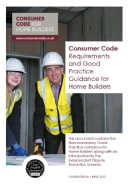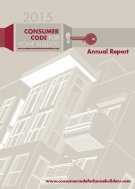Consumer Code for Home Builders
 The Consumer Code for Home Builders was launched in April 2010. According to the Code’s authors, the Code was "developed following recommendations of the Barker Review of 2004 and the Office of Fair Trading Market Study of Home Building in the UK published in October 2008." Barker recommendation 32 stated that the "house building industry must demonstrate increased levels of customer satisfaction" and required the Home Builders Federation to "develop a code of conduct by the end of 2004 for new house sales."
The Consumer Code for Home Builders was launched in April 2010. According to the Code’s authors, the Code was "developed following recommendations of the Barker Review of 2004 and the Office of Fair Trading Market Study of Home Building in the UK published in October 2008." Barker recommendation 32 stated that the "house building industry must demonstrate increased levels of customer satisfaction" and required the Home Builders Federation to "develop a code of conduct by the end of 2004 for new house sales."
What UK new homebuyers ended up with was the Consumer Code and the Home Builders Federation (HBF) Customer Satisfaction Survey. The Consumer Code is the house building industry's response to the issues raised in those reports relating to customer service and satisfaction. It was created by a "group of stakeholders within the industry" who "joined forces to consider the issues raised" to "produce a Code of Conduct for home builders." It was first launched in April 2010, over FIVE YEARS beyond Barker's deadline!
New consumer protection regulations came onto the statute on 26 May 2008. The Consumer Protection from Unfair Trading Regulations 2008 made it a legal requirement to treat consumers fairly and The Business Protection from Misleading Marketing Regulations 2008 reinforces the legal requirement not to make misleading or false statements when conducting business such as selling new homes. Any breaches of these regulations can result in criminal enforcement action, an unlimited fine and up to two years' imprisonment on conviction in the Crown Court. The government intends to repeal the Property Misdescriptions Act 1992, which has largely been superseded by the new consumer protection regulations. The Unfair Terms in Consumer Contracts Regulations 1999 can now be found within the new The Consumer Rights Act 2015
 It is more likely that the house building industry's main motivation for producing a Consumer Code was the new 2008 consumer legislation rather than the recommendations in the Barker review. Here is the OFT guidance for businesses selling homes. It is unbelievable that the industry could use compliance of this legislation as a self-promoting marketing opportunity! The Code was revised in 2017 making a successful claim more difficult.
It is more likely that the house building industry's main motivation for producing a Consumer Code was the new 2008 consumer legislation rather than the recommendations in the Barker review. Here is the OFT guidance for businesses selling homes. It is unbelievable that the industry could use compliance of this legislation as a self-promoting marketing opportunity! The Code was revised in 2017 making a successful claim more difficult.
Ensure you get a copy of the Code and READ IT BEFORE RESERVING a new home. Download the latest pdf Version 4 below:
Consumer Code Requirement and Good Practice Guidance for Home Builders
Code requirement 1.2: states home buyers "should be provided with a copy of the Code Scheme with the Reservation agreement."
The Consumer Code says it is a "voluntary industry code that is led and run by the industry." Since the Code was launched, around 16,000 house builders registered with the NHBC, Premier Guarantee or LABC Warranty must comply with the Code and its requirements. Failure to do so can result in exclusion from all registers run by the home warranty bodies that participate in the scheme, effectively making homes they build un-mortgageable.
The Code's summarises its objectives to ensure home buyers:
- Are treated fairly
- Know what service levels to expect
- Receive reliable information upon which to make their decisions
- Know how to access dispute resolution arrangements.
The Code comprises of 19 requirements that home builders must meet in the marketing and selling of their homes and with their after-sales customer service.
The Code applies to complaints arising and made within the first two years from the start date of the home warranty cover of the new home. Buyers can use the 'independent' resolution service if they believe their builder has failed to meet the requirements of the Code.
Claims cannot be made for:
- Loss of property value or blight.
- The land conveyed or its registered Title.
- Claims exceeding the £15,000 limit.
- Properties acquired by registered social landlords for rent
- Properties acquired by corporate bodies, partnerships or individuals for investment purposes.
- New homes sold on before legal completion.
- Self-built homes for own occupation.
- Personal injury
The Code's Annual report for 2011 it stated "more than 2000 builders received training" on Code compliance, including all the major house-builders accounting for the majority of new homes built in the UK.
The 2011 report also claimed that approximately 100,000* (*based on the number of warranty registrations) new home buyers have "benefited from the Code", with just one case going through the full adjudication process. This case being found in favour of the homeowner. In the Code's Annual report for 2012, the number of new cases adjudicated jumped to 13, demonstrating that a lack of disputed cases probably due to new home buyers being unaware of the Code and how to raise a complaint using the Dispute Resolution Scheme. The Code's Annual Report for 2013 again showed a surprisingly small number of new claims from buyers, just 22 in the year.
 The CCHB Annual Report for 2013/14 stated that only 32% of buyers left a housebuilders' sales offices aware of the Code. In the HBF Consumer Survey (2015), only 57% of buyers confirmed they were given a copy of the Code on reservation, this despite it being a requirement (1.2) to do so. Perhaps this explains why there are so few buyers using the Code to complain. Only 40 cases adjudicated in 2014, increasing to 60 cases in 2015, with 40 being successful in full or "in-part". The belated CCHB Annual Report 2015 (published October 2016) for the years 2014/15 and 2015/16, shows that awareness of the Code and compliance of its requirements has not improved, with just 55.5% of new homebuyers recalling being given a copy of the Code and a 53% increases in cases being referred to the scheme. The CCHB Annual Report 2016 published 5 February 2018 states "For the first time mystery shopping for the Consumer Code for Home Builders was not undertaken as there were concerns that it was measuring that which can easily be measured rather than what ought to be measured” Couldn't be anything to do with the APPG New Homes Ombudsman Inquiry? Yet again in the 2018/19 Annual Report (published 4 September 2019) there were again no details of the Code compliance audits and mystery shopping. The total amount claimed by new homebuyers was up 25%; the total amount awarded by "independent" adjudicators was down 16%. In the 2019/20 Annual Report after sifting through the industry spin, it did state a 60% increase in the number of buyer’s claiming compensation using the Code, no doubt due to it now being at no cost to buyers in doing so, but also ongoing non-compliance by housebuilders. Despite a large proportion buyer’s claims "succeeding", the amount awarded was just 9.35% of the total amount claimed in 2019 down nearly 4.5% on the previous year.
The CCHB Annual Report for 2013/14 stated that only 32% of buyers left a housebuilders' sales offices aware of the Code. In the HBF Consumer Survey (2015), only 57% of buyers confirmed they were given a copy of the Code on reservation, this despite it being a requirement (1.2) to do so. Perhaps this explains why there are so few buyers using the Code to complain. Only 40 cases adjudicated in 2014, increasing to 60 cases in 2015, with 40 being successful in full or "in-part". The belated CCHB Annual Report 2015 (published October 2016) for the years 2014/15 and 2015/16, shows that awareness of the Code and compliance of its requirements has not improved, with just 55.5% of new homebuyers recalling being given a copy of the Code and a 53% increases in cases being referred to the scheme. The CCHB Annual Report 2016 published 5 February 2018 states "For the first time mystery shopping for the Consumer Code for Home Builders was not undertaken as there were concerns that it was measuring that which can easily be measured rather than what ought to be measured” Couldn't be anything to do with the APPG New Homes Ombudsman Inquiry? Yet again in the 2018/19 Annual Report (published 4 September 2019) there were again no details of the Code compliance audits and mystery shopping. The total amount claimed by new homebuyers was up 25%; the total amount awarded by "independent" adjudicators was down 16%. In the 2019/20 Annual Report after sifting through the industry spin, it did state a 60% increase in the number of buyer’s claiming compensation using the Code, no doubt due to it now being at no cost to buyers in doing so, but also ongoing non-compliance by housebuilders. Despite a large proportion buyer’s claims "succeeding", the amount awarded was just 9.35% of the total amount claimed in 2019 down nearly 4.5% on the previous year.
The APPG Inquiry Report Into Quality of New Homes stated:
"the Code [Consumer Code for Home Builders] does not appear to give homebuyers the safeguards we think they should expect…. it does not appear to us objectively to offer consumers a wholly satisfactory form of redress….The Consumer Code for Homebuilders is limited in its scope."
This website believes the Consumer Code for Homebuilders is failing consumers and is not fit for purpose. We are campaigning for the setting up of a New Homes Ombudsman to adjudicate on every aspect of buying and owning a new home.
Reservation forms and checklists
Be aware of "Reservation Checklists" and do not sign them unless you are completely clear what you are signing for and agreeing to. Check that all plans and specifications noted on the form also refer to the current revision number or letter. Make sure that any changes, agreements and clarifications made by the builder or their representative are also recorded on this form! Trust no one and be sure to take a copy of the form away with you after signing.
In adjudication disputes, reservation checklists have been used by house builder's as evidence to dismiss house buyers' claims they were mis-sold or given incorrect information. You are signing to confirm that you "have inspected the approved plans and specifications." Take your time, carefully look at everything and make a note of what is said. One case regarding the proximity of Social Housing was dismissed because it was shown on site plans, even though omitted from the actual sales brochure!
It should be noted, that, complaints can be covered by a different and separately operated Code – the Consumer Code for New Homes (CCNH) – which has higher awards (£50,000 and maximum awards for emotional distress and/or claims for inconvenience of £1,000) is unfortunately, not available to new homebuyers with NHBC, LABC or Premier Guarantee warranties.
Information on using the Dispute Resolution Scheme and Adjudication Case Studies when making a claim for compensation from house builders.
Return to Top
















 The Consumer Code for Home Builders was launched in April 2010. According to the Code’s authors, the Code was "developed following recommendations of the Barker Review of 2004 and the Office of Fair Trading Market Study of Home Building in the UK published in October 2008." Barker recommendation 32 stated that the "house building industry must demonstrate increased levels of customer satisfaction" and required the Home Builders Federation to "develop a code of conduct by the end of 2004 for new house sales."
The Consumer Code for Home Builders was launched in April 2010. According to the Code’s authors, the Code was "developed following recommendations of the Barker Review of 2004 and the Office of Fair Trading Market Study of Home Building in the UK published in October 2008." Barker recommendation 32 stated that the "house building industry must demonstrate increased levels of customer satisfaction" and required the Home Builders Federation to "develop a code of conduct by the end of 2004 for new house sales." It is more likely that the house building industry's main motivation for producing a Consumer Code was the new 2008 consumer legislation rather than the recommendations in the Barker review. Here is the OFT guidance for businesses selling homes. It is unbelievable that the industry could use compliance of this legislation as a self-promoting marketing opportunity! The Code was revised in 2017 making a successful claim more difficult.
It is more likely that the house building industry's main motivation for producing a Consumer Code was the new 2008 consumer legislation rather than the recommendations in the Barker review. Here is the OFT guidance for businesses selling homes. It is unbelievable that the industry could use compliance of this legislation as a self-promoting marketing opportunity! The Code was revised in 2017 making a successful claim more difficult. The CCHB Annual Report for 2013/14 stated that only 32% of buyers left a housebuilders' sales offices aware of the Code. In the HBF Consumer Survey (2015), only 57% of buyers confirmed they were given a copy of the Code on reservation, this despite it being a requirement (1.2) to do so. Perhaps this explains why there are so few buyers using the Code to complain. Only 40 cases adjudicated in 2014, increasing to 60 cases in 2015, with 40 being successful in full or "in-part". The belated CCHB Annual Report 2015 (published October 2016) for the years 2014/15 and 2015/16, shows that awareness of the Code and compliance of its requirements has not improved, with just 55.5% of new homebuyers recalling being given a copy of the Code and a 53% increases in cases being referred to the scheme. The CCHB Annual Report 2016 published 5 February 2018 states "For the first time mystery shopping for the Consumer Code for Home Builders was not undertaken as there were concerns that it was measuring that which can easily be measured rather than what ought to be measured” Couldn't be anything to do with the APPG New Homes Ombudsman Inquiry? Yet again in the 2018/19 Annual Report (published 4 September 2019) there were again no details of the Code compliance audits and mystery shopping. The total amount claimed by new homebuyers was up 25%; the total amount awarded by "independent" adjudicators was down 16%. In the 2019/20 Annual Report after sifting through the industry spin, it did state a 60% increase in the number of buyer’s claiming compensation using the Code, no doubt due to it now being at no cost to buyers in doing so, but also ongoing non-compliance by housebuilders. Despite a large proportion buyer’s claims "succeeding", the amount awarded was just 9.35% of the total amount claimed in 2019 down nearly 4.5% on the previous year.
The CCHB Annual Report for 2013/14 stated that only 32% of buyers left a housebuilders' sales offices aware of the Code. In the HBF Consumer Survey (2015), only 57% of buyers confirmed they were given a copy of the Code on reservation, this despite it being a requirement (1.2) to do so. Perhaps this explains why there are so few buyers using the Code to complain. Only 40 cases adjudicated in 2014, increasing to 60 cases in 2015, with 40 being successful in full or "in-part". The belated CCHB Annual Report 2015 (published October 2016) for the years 2014/15 and 2015/16, shows that awareness of the Code and compliance of its requirements has not improved, with just 55.5% of new homebuyers recalling being given a copy of the Code and a 53% increases in cases being referred to the scheme. The CCHB Annual Report 2016 published 5 February 2018 states "For the first time mystery shopping for the Consumer Code for Home Builders was not undertaken as there were concerns that it was measuring that which can easily be measured rather than what ought to be measured” Couldn't be anything to do with the APPG New Homes Ombudsman Inquiry? Yet again in the 2018/19 Annual Report (published 4 September 2019) there were again no details of the Code compliance audits and mystery shopping. The total amount claimed by new homebuyers was up 25%; the total amount awarded by "independent" adjudicators was down 16%. In the 2019/20 Annual Report after sifting through the industry spin, it did state a 60% increase in the number of buyer’s claiming compensation using the Code, no doubt due to it now being at no cost to buyers in doing so, but also ongoing non-compliance by housebuilders. Despite a large proportion buyer’s claims "succeeding", the amount awarded was just 9.35% of the total amount claimed in 2019 down nearly 4.5% on the previous year.

